With a huge summer of golf coming up in Australia, here are 18 of the greatest shots ever played on home soil.
 O’HERN’S COOLUM ESCAPE
O’HERN’S COOLUM ESCAPE
Nick O’Hern was on 23-under and striding towards victory in the 2006 Australian PGA Championship at the Hyatt Coolum Resort. After marking his ball on the 72nd hole he stood back to contemplate the two-foot par putt that would give him his first professional win in seven years.
RIGHT: PHOTO: Getty Images.
Since his maiden title in 1999 – the Coolum Classic at the same course – O’Hern had notched 56 top-10s, been runner-up 12 times and third-placed 11 times. No-one doubted his metronomic consistency. Indeed, they called him ‘Mr Consistency’.
But questions were being asked. Why couldn’t he get it done?
Then he missed the two-foot putt. It didn’t touch the hole. The crowd gasped. “I just wanted to snap my putter, two-and-a-half-feet to win the tournament and I pulled it,” O’Hern said. For agonising moments, he stood aghast, ashen-faced, thunderstruck. And he remained that way for some time.
“Had he jumped in the lake there and then, no one would have blamed him,” veteran scribe Peter Stone wrote.
It meant a play-off with Peter Lonard, who also felt for O’Hern. “I said sorry when he missed the putt and he said, ‘let’s go and have some fun out there’,” Lonard said. “What the hell does that mean? I thought if I’d missed it, I probably would have coat-hangered someone.”
Three times the pair teed off on 18, three times they returned with pars. On their fourth attempt both men’s approach found the bunker. O’Hern would go first. The flag was at the back of a green which sloped away towards water. He had not won in seven years. He had missed a two-footer to win. It was knee-trembler territory.
His escape always looked good. It landed just on the green, rolled down the slope and, of course, fell in. “It was the bunker shot of my life,” O’Hern said. “It was my number one golf shot. It was as good as it gets.”
Near to tears on 18 he added: “It was hard work after I missed that putt [on 18]. To regroup from there was a real challenge. It’s been a long time waiting for a win. I know a lot of people said it wasn’t going to happen, but it has, and I couldn’t be happier.”
And then he cried.
Lonard was gracious in defeat and quipped: “He pulled the rope off my neck, but he hung me later … he may as well have done it the first time.”
POPEYE’S CHIP SINKS TIGER & FRED
The President’s Cup has been run 14 times since 1994 and been won 12 times by the United States. There has been one tie – when Gary Player and Jack Nicklaus called it a day in the dark when 17-all in George, South Africa, 2003 – while the Internationals’ sole victory came at Royal Melbourne in 1998.
And it was a chip by Craig Parry that set wheels in motion.
On day two Parry was paired with Shigeki Maruyama – ‘the Smilin’ Assassin’ adopted by Aussie crowds and who would go 5-0 – and playing foursomes against, ahem, Tiger Woods and Fred Couples.
Parry and Maruyama were similarly statured men – they looked like a couple of chubby clubbies taking on the flat-bellied buck pros from the PGA Tour. Yet Parry had long thrived on being underestimated, and after 16 holes he and Maruyama were down by one, two to play.
After Parry pitched a tricky one out of sandy waste and onto the 17th green, Maruyama holed a curling 35-foot putt to win the hole and halve the match. And he and Parry strode to the last tee riding a surge of home support.
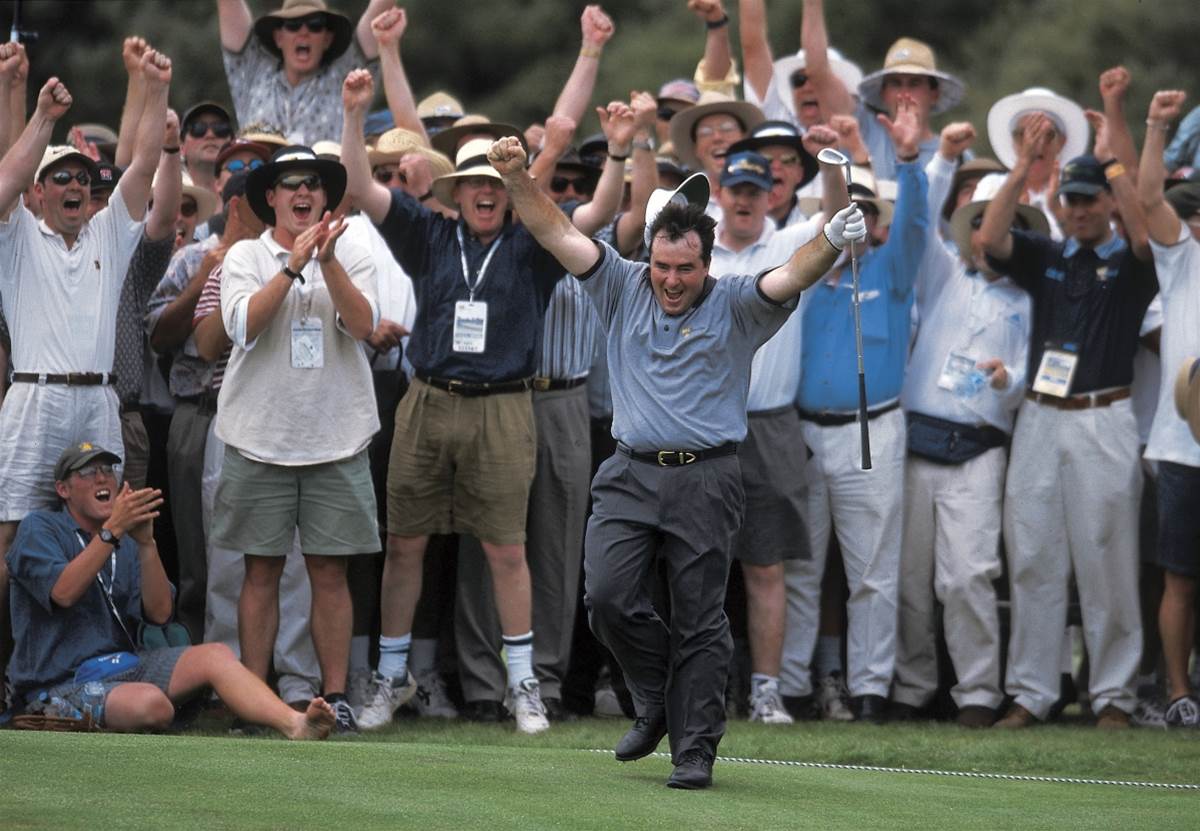
Parry hit the fairway on 18 but Maruyama’s approach was tugged left. The ball was in slightly fluffy rough and Parry was faced with a 20-metre chip-and-run. He gripped down on his wedge, landed the ball just off the green and, along with an ever-noisier gallery, watched it roll inexorably, perfectly into the cup.
And the Melbourne sports fans roared like Warney had knocked over a Pom.
“I don’t want to say it was the turning point of what happened in the Presidents Cup in ’98, but it more or less was,” Parry told Inside Sport. “Another couple of guys behind us turned their game around as well, and we’re on top, and the Americans are shell-shocked.”
The Internationals ultimately romped home 20 to 11.
LONGEST. DRIVE. EVER
One day in 2004 Mark Bylsma stood on the 1st tee at Duntryleague Country Club in Orange and hit a golf ball the astonishing distance of 401.1m. It remains an Australian record for the longest blow on these shores recorded in a sanctioned long-driving competition.
RIGHT: PHOTO: Brendan James.
Eight years later at The Lakes during the 2012 Australian Open (won by 53-year-old Peter Senior) Bylsma equalled his own national record.
KARRIE’S OPEN EAGLE
As she told Karen Harding in the November 2022 issue of Golf Australia magazine, Karrie Webb turned up at Yarra Yarra for the 2000 Australian Women’s Open “on a bit of a tear”. In the 14 months since the Open in November of 1998, Webb had won six LPGA tournaments including the Ladies Masters at Royal Pines and her first major, the Du Maurier Championship. She’d been top-10 in 22 of 25 starts.
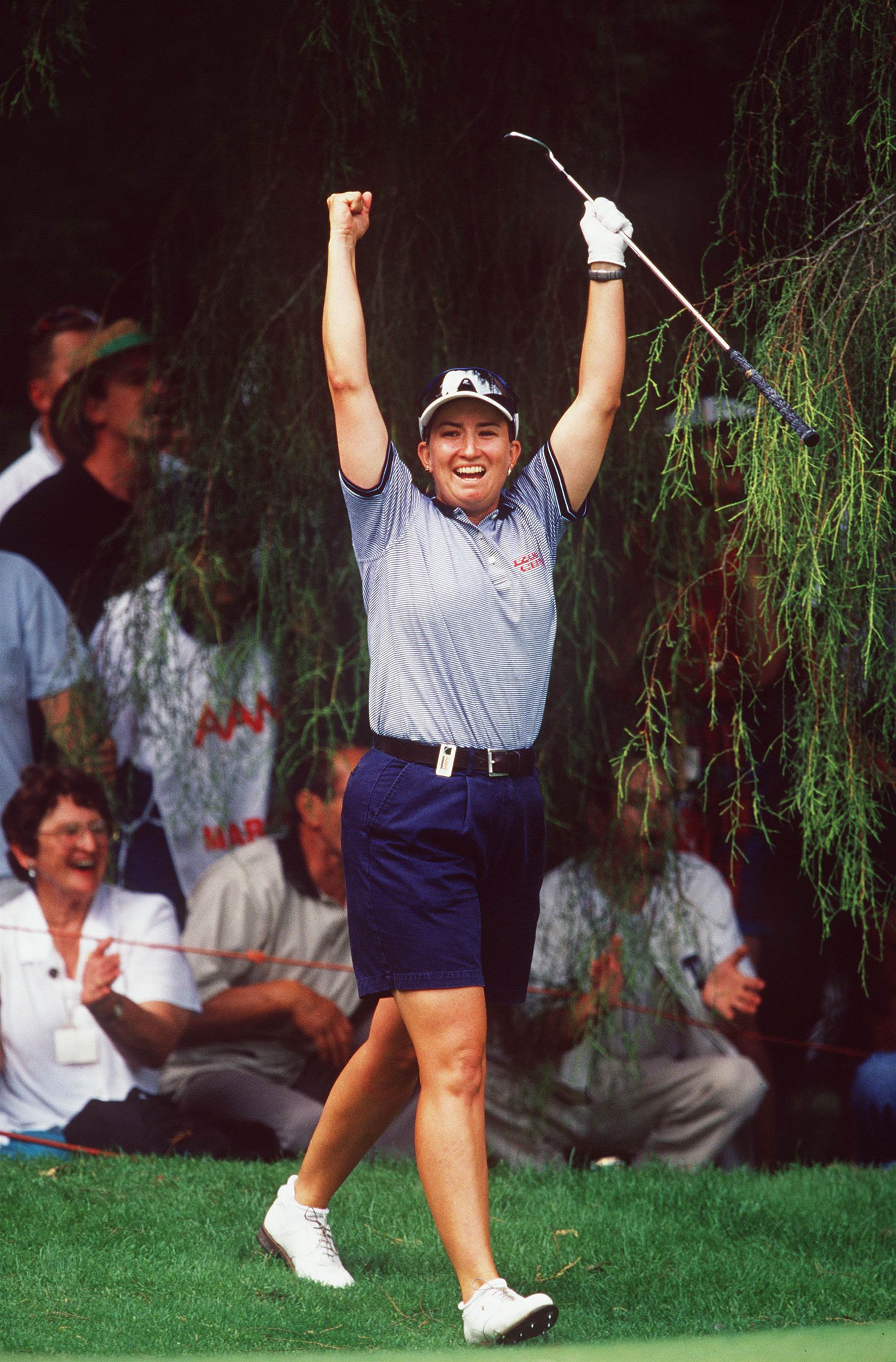
Notables in the Open field included Laura Davies and Rachel Hetherington. But Webb was odds-on. And with nine holes to play Webb led Hetherington by two and Davies by three. And then things got real.
Davies fired a sizzling 66 – and lost by five. Hetherington birdied the last six holes and finished with an eight-under 65 – and lost by three. And Webb reeled off four birdies and an eagle to finish 22-under and break Jane Crafter’s course record with 64.
RIGHT: PHOTO: Getty Images.
The game-breaker was her chip on 16.
As Harding wrote: “The pin that day was deep to the back of a sloping back-to-front green and Karrie in a swale behind it. Hoping to finish within 10 feet, she bumped the ball into the bank with her sand wedge and watched as it slowly, slowly, headed ever closer to the hole before falling in.”
Standing next to Hetherington, who had a 20-foot putt for eagle, was her caddie Shaun McBride. “When I chipped in, Shaun just shook his head at me and told me to ‘eff’ off!” Webb said.
NORMAN’S ALBATROSS
Greg Norman played his first Australian Open at The Australian Golf Club in 1977 and won the last of five national titles at the same course in 1996. In between he made an albatross on the par-5 5th hole during round two of the 1990 Australian Open.
“I feel good,” Norman said afterwards. “I guess holing a 279-yard (246-metre) shot with a 3-wood would make anyone feel pretty good. Any time you do something for the first time, it feels wonderful. I saw it go in — it was a perfect shot. The ball never left the line of the flag and rolled in like a putt.”
Norman led the field at the halfway mark but faded with 76-72 to tie third with Wayne Riley. The tournament was won by American John Morse who beat Craig Parry on the first play-off hole.
SPENCE SLAYS THE SHARK
Craig Spence was a 24-year-old Huntingdale member hailed as ‘the kid from Colac’ when he began the final round of the 1999 Australian Masters leading by two shots over his playing partner, the six-time Masters and five-time Australian Open champion, Greg Norman.
The Shark had stormed up the leaderboard on Saturday with a sizzling 66 and, as ever, attracted massive galleries powerless to his siren song. And it was widely assumed Spence, who’d shot 64 on the Thursday but whose biggest win to date was the 1997 Borrego Springs Open on a U.S Mini Tour, would capitulate under the pressure of the great Shark hunt.
Didn’t happen.
After 17 holes the pair was all square at 15-under. Norman had the honour on 18 and smashed his driver down the middle in typical fashion, the greatest driver of the golf ball the game had seen. Spence found the cut stuff, too, albeit nearly 20 metres aft.

You’re up, Craig.
In the Huntingdale clubhouse Peter Lonard was standing on a table watching events. He told Golf Australia what happened next was “incredible.”
“Because you know he was playing Norman and I think everyone expected him to fold,” Lonard said. “They used to have this back left-hand corner pin that was impossible to get to – unless you were willing to lose.”
Spence, apparently, was – because he went straight at it.
From 176 metres his 6-iron was pure. It pitched five metres under the hole and rolled to 60cm. Norman’s 8-iron found the middle, but his 40-foot putt pulled up just short. Spence – with an upright, stiff-looking stroke, made the birdie putt – just the 20th in four rounds on 18 – and pulled on the bright gold jacket.
GREEN’S ALBATROSS ACE
Richard Green was playing in the Pro-Am of the 2015 Victorian Open at 13th Beach Golf Links when his downwind drive from 358 metres on the par-4 15th (which usually plays as the opening hole of the Beach Course) rolled into – and then somehow spat horizontally out of – the front, left greenside trap. The ball then sped towards the hole and dropped in.
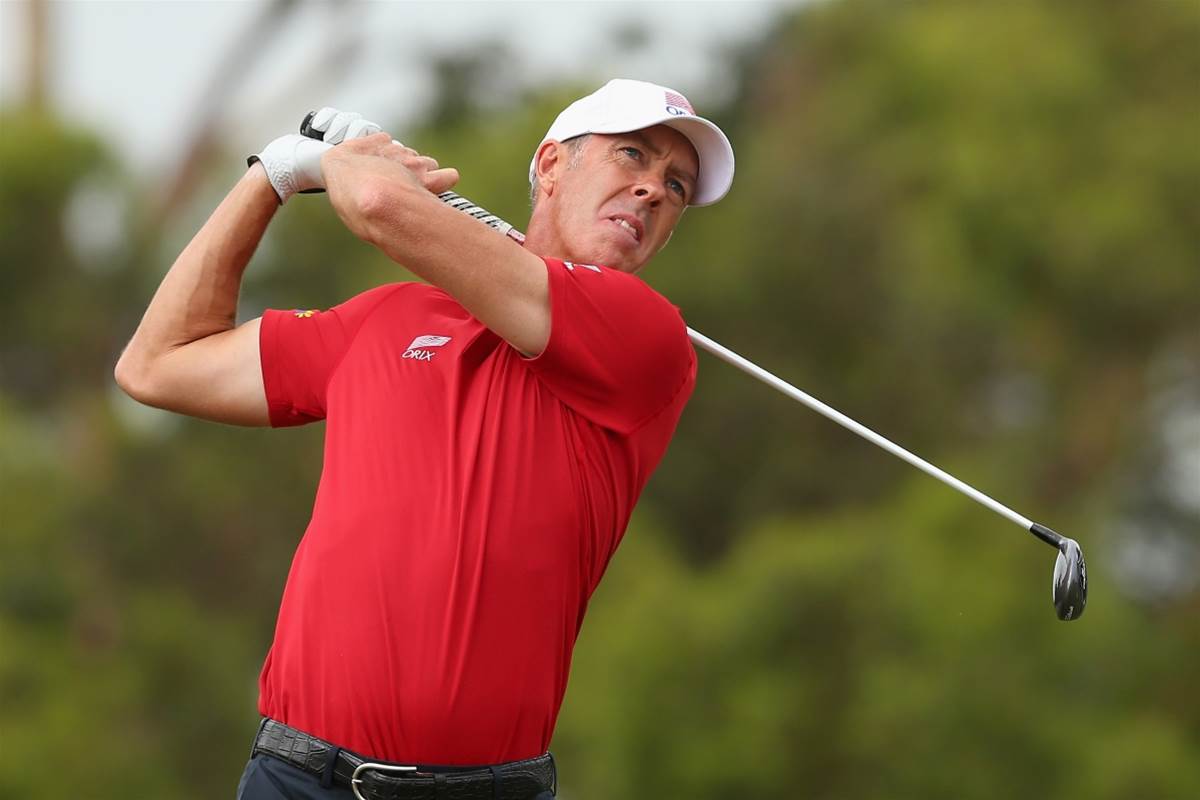
“It’s the first time ever,” Green said on viral video. “An albatross – they don’t happen.”
 ADAM’S MAGIC 6-IRON
ADAM’S MAGIC 6-IRON
In the opening round of the 2011 Australian Open at The Lakes, Adam Scott was 199 metres from the flag on the par-5 8th hole when his 6-iron drew in on the north-east breeze, pitched six metres under the hole and rolled in, to great acclamation from the gallery and caddie Steve Williams.
RIGHT: PHOTO: Getty Images.
“The shot looked like it was heading just right of the hole. It drew just more than I wanted it to but a bit of luck goes a long way,” Scott said.
“It’s the first (albatross) I’ve had since I was 17 in the Greg Norman Junior Masters (at Coolangatta-Tweed in 1997) so it’s quite a while between drinks.”
It was the first Australian Open albatross carded since Matthew Zions holed a 223-metre 5-wood for two on the par-5 14th hole at The Australian Golf Club in 2007.
 NEWTON’S ROAR
NEWTON’S ROAR
Immediately following his closing 72 on the Sunday of the 1979 Australian Open at Metropolitan, Jack Newton described his round as “rubbish”, so often was he in the trees, rough and bunkers.
Yet on a course described by journalist Terry Smith as “tight and treacherous” it was a round Newton’s friend Seve Ballesteros would have been proud.
RIGHT: PHOTO: Getty Images.
From a fairway bunker on 15, one of eight traps he found that day, Newton hit what he thought was a pure approach only to see the ball run off the back of the green. His 10-metre chip with an 8-iron pitched perfectly, ran out, hit the flag and dropped in. The birdie took him to even par and equal-top with Greg Norman and Bob Shearer.
“Considering I had already holed a bunker shot, putted in from off the green and now chipped in this really was an incredible round,” Newton recalled in Smith’s ‘The Champions and The Courses They Played’. “Houdini would not have got out of some of the spots I found myself in.”
Newton appeared destined for a play-off until Norman, who had led by four with nine holes to play, three-putted 18 and lost by a shot.
Newton finished the only player not over par in a field which along with Norman featured Ballesteros, Gary Player, David Graham, Fuzzy Zoeller, Hubert Green, Graham Marsh, Bruce Devlin and Billy Dunk.
 SARAZEN THRILLS IN TAMWORTH
SARAZEN THRILLS IN TAMWORTH
Gene Sarazen toured the world in 1934 after ignoring Dr Clifford Roberts’ invitation to play in his new ‘Masters’ invitational tournament at Augusta National. (Sarazen binned the letter without opening it, believing that Roberts was “trying to sell me insurance or something.”)
RIGHT: PHOTO: Getty Images.
Sarazen, the 1932 Open Champion, arrived in Australia with trick-shot artist and 1920 Australian Open champion Joe Kirkwood, and spent two months touring the country, literally, playing matches everywhere from Narrandera to Toowoomba.
In October 1934, after Sarazen and his wife were welcomed to Tamworth by an informal function at the local Rotary Club, Kirkwood took on the local links and its new ‘grass’ greens, recently seeded from the sand scrapes.
The 1st hole at Tamworth was a 520-metre uphill par-5. According to reports the course had been drenched by two inches of rain. Yet Sarazen’s second shot reached the green in two. No-one had seen anything like it. No-one believed it possible.
It was a display of power-hitting which “thrilled the locals who had never witnessed such an exhibition,” according to The Sydney Morning Herald. Sarazen would shoot 62 and smash the club record of 66 (held by the great Walter Hagen).
A year later Sarazen did take up Roberts’ offer of an invite to the Masters and won the tournament after he landed the ‘Shot Heard Around the World’ in the final round, a 220-yard ‘cleek’ (call it a 5-wood) that saluted for an albatross on the par-5 15th.
THE VON MAKES KOOYONGA SPLASH
Peter Thomson had just turned 21 when he teed off in the 1950 Australian Open at Kooyonga. After rounds of 73, 76 and 72 left him eight shots behind leader Norman von Nida, the Victorian described in reports as an “assistant professional” proceed to tear the place apart.
And von Nida knew it.
“Peter had played nine holes before I’d teed off,” von Nida said. “He’d shot 30 on the first nine. It made it very, very difficult for me because the wind had sprung up and it was a much more difficult course than what it had been in the morning. It meant I had to concentrate more.”

Thomson would post a course record 66 but the Von’s powers of concentration held up until the final hole when his approach found a greenside trap. The wind was up. The gallery surrounding the green was six deep without ropes. It was von Nida’s sixth tilt at a championship he’d never won.
His bunker shot landed with butterfly’s feet to three feet. Then he holed the putt and won by one from Thomson with Kel Nagle two back and Ossie Pickworth, who played much of his round with a cigarette between his lips, in fourth.
BY JOH, WHAT A SHOT!
Tiffany Joh was an 18-year-old amateur from San Diego on her first trip to Australia when she teed it up in the 2005 Ladies Masters at Royal Pines. After 28 holes she was one-under and no guarantee to make the cut.
Then she went, to court some Australian vernacular, ‘berko’: four birdies in seven holes were followed by albatross on the last, courtesy of a 192-metre 5-wood. It all added up to a closing score of 63, which equalled the course record set by Karrie Webb and also equalled by Japan’s Ai Miyazato the day before.
“I really can’t put into words how I feel,” Joh said afterwards. “I had no idea until I checked the hole.”
It was the second-ever albatross in women’s professional golf in Australia following one by England’s Alison Nicholas.
 BEAR’S BIG BASH
BEAR’S BIG BASH
The first Australian Open at The Lakes was in 1964 and graced by a chubby, 24-year-old from Ohio whom Australian sportswriter Don Lawrence had coined, ‘The Golden Bear’. He was, of course, then three-time Major winner Jack Nicklaus.
A noted long hitter, a storyline leading into the tournament was whether Nicklaus would take on the monstrous 262-metre water-carry at the par-4 16th on a direct route to the green. Such was the weight of risk against reward that very few players, even with the wind, would go at the green with driver.
RIGHT: PHOTO: Getty Images.
Nicklaus didn’t either – he used 3-wood. His ball landed on the green and set up a birdie-three and a final round five-under 67. The score saw him draw level with Bruce Devlin, whom Nicklaus then beat by three shots in the 18-hole play-off to win his first of six Australian Open titles.
Ironically, in the first round, Nicklaus had made a triple-bogey on 16 after playing the hole the ‘conventional’ way.
 RADAR WAS ON
RADAR WAS ON
Robert Allenby was a whip-thin 20-year-old amateur out of Box Hill Golf Club when he lasered a 5-iron at Royal Melbourne’s 18th flag in the closing stages of the 1991 Australian Open.
When his ball stiffed to a metre and he made the subsequent putt, he shared top billing on the leaderboard of his national open championship. And the press had a hero. They dubbed him ‘New Shark’ and ‘Normanby’.
RIGHT: PHOTO: Getty Images.
But another man with a couple of nicknames wasn’t done. Wayne ‘Radar’ Riley, aka ‘Wild Colonial Boy’, had birdied 16 and birdied 17 and joined Allenby at three-under atop the leaderboard. His approach to 18 came to rest 40 feet from the cup. Two putts for play-off with Kid Wonder was a likely outcome, according to popular opinion.
Riley, of course, stepped up, pulled the trigger and set it free, and watched it fall into the cup. And then, wearing a thick
Ping hat and a lemon-yellow sleeveless cardigan-come-waistcoat, Riley ran about the green in his spikes with his fist in the air like Lionel Messi.
Even if he still wasn’t sure he’d won.
“I actually didn’t know for sure I had won when I holed that putt,” Riley later told John Huggan. “But nobody coming along behind beat my score. I remember Robert hugging me after it was over. I didn’t even know him at the time. ‘That was incredible,’ he said. And it was.”
A year later, golf writer Peter Stone took Riley to the same spot on 18 and asked him to repeat the putt, which Riley did, sinking it on his 25th attempt.
And his 26th.
 CHASE’S ADELAIDE ACE
CHASE’S ADELAIDE ACE
LIV Golf Adelaide in April this year is the richest golf tournament ever played in Australia and attracted massive, sold-out crowds to each of its three rounds.
The most popular hole at The Grange was the par-3 12th, fashioned after the ‘Party Hole’ at TPC Scottsdale and renamed the ‘Watering Hole’ for Australian sensibilities.
And it was all quite a to-do.
RIGHT: PHOTO: Getty Images.
A famous DJ did a ‘shoey’. A beer-bellied American comedian took his shirt off and twirled it around his head. And after each group teed off and wandered to the green through the alley of corporate tents, plastic cups of beer rained onto the tee like frothy mortars.
If Old Tom Morris was turning in his grave, Chase Koepka’s ace on day three may have had the old boy subterranean breakdancing. When Koepka’s slightly drawn 9-iron pitched, bounced, and rolled into the hole, it was like the entire Grange went batshit crazy.
As you may have seen on so many viral videos, so many cups rained down onto the tee, green and in-between that beer-mist filled the air like hops-based humidity. Koepka celebrated the achievement with a series of leaping chest-bumps with playing partners Ian Poulter and Paul Casey. Patrons roared like Romans.
Koepka told reporters he “smelt like beer the entire rest of the day.”
“That’s unbelievable,” he said. “That’s a once-in-a-lifetime experience and something to always remember. The next couple of hours I was out there, I was getting ovation after ovation as I walked up to every shot. It was pretty cool. That’s probably what Cam Smith felt like the entire week, but at least I got a glimpse of it.”
 FINCHY’S FLUSHED 5-IRON
FINCHY’S FLUSHED 5-IRON
Roger Mackay was in a rich vein of form heading into the 1988 Australian Masters at Huntingdale. He’d won the 1987 Victorian Open and Australian PGA and was a crowd favourite with his handsome looks and ‘Mr Nice Guy’ persona.
When he birdied 18 on the Sunday and forced his way into a three-way play-off with Ian Baker-Finch and Craig Parry, momentum and many in the large gallery were with the West Australian.
RIGHT: PHOTO: Getty Images.
Until they weren’t, when Baker-Finch stiffed his 5-iron to 30cm on the first play-off hole. It was Baker-Finch’s first play-off win in six attempts and came over international drawcards Greg Norman, Bernhard Langer, Ian Woosnam and Nick Faldo.
 TOOGOOD’S HOLE-IN-ONE
TOOGOOD’S HOLE-IN-ONE
One of Australia’s greatest ever amateurs, Peter Toogood, was always going to make a mark on the game.
RIGHT: PHOTO: Des Tobin.
He, and his brother John, were born into a family of very good golfers. Peter’s father, Alf, was a professional and his grandfather, Alf Sr, was a pro in England and had finished fourth and T9 in the Open Championships of 1894 and 1895.
Alf Toogood moved to Tasmania from Adelaide in 1936 to take up the professional job at Kingston Beach Golf Club south of Hobart.
It was here, in January 1939, that the name Peter Toogood first came to the attention of the golfing world when the then eight-year-old made a hole-in-one on the 133-yard 7th hole, using a hickory-shafted 3-iron his father had made for him.
The incredible shot set the wheels in motion for a wonderful life in golf.
Peter never followed his father and grandfather into professional ranks, but he had an incredible amateur career, finishing the leading amateur at The Open in 1954, and the Australian Open four times between 1950 and 1957. He won the Australian Amateur in 1954, defeating his brother, John, in the final. He also won the Tasmanian Open eight times, and finished runner-up in the championship in 1950 … behind his father.
 ROYALTY RULES BAROOGA
ROYALTY RULES BAROOGA
With nine holes to play in the 2022 Australian Mini Golf Open at the testing Sporties course at Cobram Barooga Golf Club, Henry Epstein – who goes everywhere by ‘King Henry’ – was leading by two shots from seven-time national champion Allan ‘The Putter King’ Cox and by four from rising touring professional Josh ‘The Putting Wonder From Down Under’ Mars.
RIGHT: PHOTO: Supplied.
And then Mars went into orbit. He aced 11, 12, 13 and 15 to sit just two back. Momentum? He was a runaway train.
And Esptein knew it.
“I knew he was coming,” Epstein says. “He was on the birdie train. The only way to stop it was to get on board.”
The 16th at Sporties is a difficult, undulating 30-footer with vertical cinder blocks and a pin-high berm left that players must roll upon with sufficient speed to break 90-degrees right and feed down to the hole … which is exactly what Epstein produced, his ace drawing him clear of the panting pack, even with Mars’ one off the wall on 17.
Related Articles
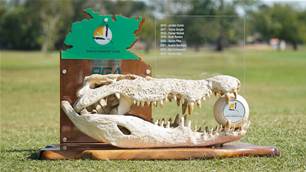
Complete guide to the NT PGA Championship
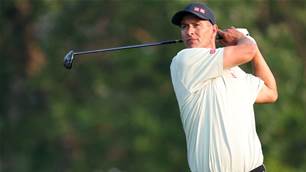
Scott headed home for Australian majors
.jpg&h=172&w=306&c=1&s=1)












